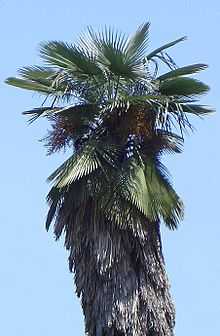Trachycarpus takil
| Trachycarpus takil | |
|---|---|
 | |
| Scientific classification | |
| Kingdom: | Plantae |
| (unranked): | Angiosperms |
| (unranked): | Monocots |
| (unranked): | Commelinids |
| Order: | Arecales |
| Family: | Arecaceae |
| Genus: | Trachycarpus |
| Species: | T. takil |
| Binomial name | |
| Trachycarpus takil Becc. | |
Trachycarpus takil (Kumaon Palm) is a fan palm native to the foothills of the Himalaya in Kumaon in northwestern India, and possibly in adjacent western Nepal; it grows at altitudes of 1,800–2,700 metres (5,900–8,900 ft).
It grows to 10–15 metres (33–49 ft) tall, with a rough trunk covered in fiber from the old leaf bases; it is easily distinguishable from Trachycarpus fortunei from its infancy by the young plants having the tendency to growing obliquely; by the young trunk being distinctly conical; by the adult trunk covered with very tightly clasping (not ruffled) chestnut brown fibers; by the short, triangular, erect ligulas on the leaf sheaths of the terminal shoot; by the leaves more spreading and those of the previous year being placed just below the last flowering spadices, reflexed, although still alive, by the leaf blade being irregularly divided only down to about the middle; finally by the fruit being more distinctly uniform or considerably broader than high. Additionally, the first leaves of sprouting T. takil seeds are duplicate (having only two ridges differing from T. fortunei with its quadruplicate first leaves.)
It was first discovered by a Major Madden, a British Army colonel with a passion for botany stationed in the Himalayas during the 1840s. Unfortunately, while Madden produced precise descriptions of both the plant and location, he made the fatal mistake of assuming it to be Trachycarpus martianus, failing to realize it was a separate species, thus losing the chance to claim its discovery.
First officially described by the Italian Botanist Odoardo Beccari in 1905 ("Le Palme del Genere Trachycarpus", in Webbia I). The leaves all permanent as in Tr. fortunei. Petioles about as long as the blade. Blade 3/4 orbicular, 1–1.2 m in diameter, irregularly divided down to about the middle into 45–50 segments, 60-85 cm in length from the top of the petiole (hastula) to the apex of the median segments, the latter stiff and erect, not with drooping tips. (Beccari, O. 1931: Asiatic palms: Corypheae. Ann.Royal Bot. Gard. 13, Calcutta)
It is one of the cold hardiest palms to produce a tall trunk, tolerating temperatures down to −14 °C to possibly −20 °C, but with leaf damages or total defoliation.
Some plants in cultivation in the USA under the name Trachycarpus takil are actually misnamed specimens of the dwarf form of T. fortunei, also known as T. wagnerianus.
References
- Husain, T., & Garg, A. (2004). Trachycarpus takil Becc. is not a 'rare' palm. Current Science (India) 86 (5): 633-634. Available online (pdf file).
- Kulkarni, A. R. & Mulani, R. M. (2004). Indigenous palms of India. Current Science (India) 86 (12): 1598-1603. Available online (pdf file).
- PACSOA: Trachycarpus takil
- Flora of Nepal: Trachycarpus takil
- Palm hardiness trial